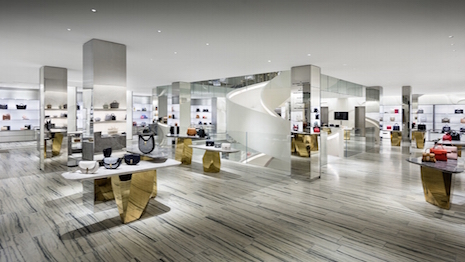 Image courtesy of Neiman Marcus
Image courtesy of Neiman Marcus
As per capita purchasing power increases, proportional spending on personal goods has decreased, according to a new report from GfK.
For the 28 European Union member states, retail sales accounted for 31.2 percent of spending in 2013 but only 30.4 percent last year. As newly earned purchasing power manifests itself in cultural and recreational spending, brands must invest in the experiential economy to regain prominence.
"Luxury segments generally benefit from higher per-capita purchasing power – this is a deviation from the trend for retail shares in general," said Christian Heller, fashion and lifestyle expert for GfK's geomarketing division and co-author of the study. "For example, if you compare regional purchasing power levels in Germany with the purchasing power for jewelry and watches, there is a connection.
"Interestingly however, the relation between high income and regional potential for spendings on luxury goods is not linear," he said. "After all, housing costs differ regionally as well, to name just one influencing factor."
Decreased spending
While a drop of less than one percentage point may seem minor, in a market of more than $250 billion, it represents more than $2 billion. While increased purchasing power will not necessarily result in money spent in previously unattainable sectors, it also means that wealth creation in mature markets primarily represents untapped potential.
 Saks Fifth Avenue flagship
In general as purchasing power parity increases, consumers spend more on recreational activities, entertainment and culture. This is visible in the range of private expenditure on retail in Italy (25.8 percent) and Russia (59.2 percent). The vast difference in private expenditure rates reveals differences in standard of living, as online growth does not mitigate this decrease.
This trend intimates long-term concerns for the retail world. It is currently most visible in highly developed markets, where a decrease in proportional retail expenditure means that business expenses could outpace growth in physical channels as commercial rent and other costs increase.
The erosion of retail spending will eventually make its way into the mainstream, presenting difficulty for physical stores. The future of bricks-and-mortar retail thus depends on encouraging consumers, and especially the digital natives growing into eras of increased purchasing power parity, to shop in-store with experiences akin to those in other sectors.
As GfK notes, in-store retail appeals to rational needs – the ability to touch a product or receive a purchase immediately – while online retail appeals to emotional needs such as ease and convenience.
Saks Fifth Avenue flagship
In general as purchasing power parity increases, consumers spend more on recreational activities, entertainment and culture. This is visible in the range of private expenditure on retail in Italy (25.8 percent) and Russia (59.2 percent). The vast difference in private expenditure rates reveals differences in standard of living, as online growth does not mitigate this decrease.
This trend intimates long-term concerns for the retail world. It is currently most visible in highly developed markets, where a decrease in proportional retail expenditure means that business expenses could outpace growth in physical channels as commercial rent and other costs increase.
The erosion of retail spending will eventually make its way into the mainstream, presenting difficulty for physical stores. The future of bricks-and-mortar retail thus depends on encouraging consumers, and especially the digital natives growing into eras of increased purchasing power parity, to shop in-store with experiences akin to those in other sectors.
As GfK notes, in-store retail appeals to rational needs – the ability to touch a product or receive a purchase immediately – while online retail appeals to emotional needs such as ease and convenience.
 Affluent shoppers
Accordingly, the survival of stores is disproportionately hinged on location compared to the past when online alternatives were less viable. This means stepping off the beaten track from established shopping roads to trendy, populous areas, often frequented by those attaining newfound purchasing power.
Showcasing products in a careful, more considered way also encourages consumers to spend more time with each item – exactly the kind of thing they cannot do online. So significant is this aspect of in-store shopping that some research indicates that retailers can charge 10-15 percent more for comparable product is layout is optimal.
Concept stores focusing on particular themes consistent with brand lifestyles and creating opportunities to express social, political and cultural interests through the act of visiting a store are also cited as tactics to revitalize the retail store.
Stores of the future
Generally speaking, stores must adapt to changing consumer expectations, embracing technology being the simplest and among the most effective way to do so.
For example, department store chain Barneys New York is offering its consumers an elevated shopping experience by embracing in-store technologies at its recently opened Chelsea flagship.
The use of iBeacons, a mobile application and opt-in purchase history has altered the shopping experience. Aware of the tendency of consumers to use mobile phones while shopping, often comparing prices and merchandise with competitors, iBeacons will push product information and brand content to consumers when they are near the associated products.
Likewise, store associates can identify particular customers based on where they are in the store and access their purchase history, thereby allowing for a personalized shopping experience. The layout has also been altered in a nontraditional form in accordance with data showing the footpath of consumers, and a restaurant has been added.
The restaurant and layout position the new Barneys as a place to linger. Barneys’ Chelsea location has a more residential atmosphere rather than a pure retail experience, as the online environment now offers the flood of merchandise sometimes associated with physical stores (see story).
Affluent shoppers
Accordingly, the survival of stores is disproportionately hinged on location compared to the past when online alternatives were less viable. This means stepping off the beaten track from established shopping roads to trendy, populous areas, often frequented by those attaining newfound purchasing power.
Showcasing products in a careful, more considered way also encourages consumers to spend more time with each item – exactly the kind of thing they cannot do online. So significant is this aspect of in-store shopping that some research indicates that retailers can charge 10-15 percent more for comparable product is layout is optimal.
Concept stores focusing on particular themes consistent with brand lifestyles and creating opportunities to express social, political and cultural interests through the act of visiting a store are also cited as tactics to revitalize the retail store.
Stores of the future
Generally speaking, stores must adapt to changing consumer expectations, embracing technology being the simplest and among the most effective way to do so.
For example, department store chain Barneys New York is offering its consumers an elevated shopping experience by embracing in-store technologies at its recently opened Chelsea flagship.
The use of iBeacons, a mobile application and opt-in purchase history has altered the shopping experience. Aware of the tendency of consumers to use mobile phones while shopping, often comparing prices and merchandise with competitors, iBeacons will push product information and brand content to consumers when they are near the associated products.
Likewise, store associates can identify particular customers based on where they are in the store and access their purchase history, thereby allowing for a personalized shopping experience. The layout has also been altered in a nontraditional form in accordance with data showing the footpath of consumers, and a restaurant has been added.
The restaurant and layout position the new Barneys as a place to linger. Barneys’ Chelsea location has a more residential atmosphere rather than a pure retail experience, as the online environment now offers the flood of merchandise sometimes associated with physical stores (see story).
 Barneys New York Chelsea flagship
Despite many industry insiders predicting that bricks-and-mortar will be phased out, a November 2015 report from Boston Retail Partners noted that 90 percent of retail sales transactions still occur in-store.
Boston Retail Partners’ “The Future Store Manifesto” focuses on how future retail will be an “omnichannel theatre blending the physical sensory experience with the convenience of digital,” a strategy that is slowly being implemented by retailers across industry sectors. As consumer expectations have shifted toward increased mobile interaction, retailers have been faced with challenges, and necessary adaptations are needed to deliver the experience expected in-stores (see story).
Barneys New York Chelsea flagship
Despite many industry insiders predicting that bricks-and-mortar will be phased out, a November 2015 report from Boston Retail Partners noted that 90 percent of retail sales transactions still occur in-store.
Boston Retail Partners’ “The Future Store Manifesto” focuses on how future retail will be an “omnichannel theatre blending the physical sensory experience with the convenience of digital,” a strategy that is slowly being implemented by retailers across industry sectors. As consumer expectations have shifted toward increased mobile interaction, retailers have been faced with challenges, and necessary adaptations are needed to deliver the experience expected in-stores (see story).
